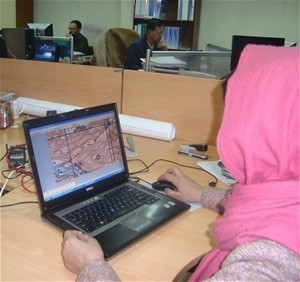
Fatima Kohstani works for USAID’s Afghanistan Infrastructure Rehabilitation Program as an engineer specializing in hydraulic design.
USAID/AIRP
Fatima Kohstani designs road structures to improve mobility and transportation in her country.
4 MAY 2010 | KABUL, AFGHANISTAN
Women are a growing force in the Afghan workplace. To advance the role of women in society, the U.S. Government supports women entering into the science and engineering fields. Female engineers in Afghanistan are strong pioneers who have broken through gender stereotypes to contribute to their country’s development.
Fatima Kohstani is an engineer with USAID’s Afghanistan Infrastructure Rehabilitation Program (AIRP). With a master’s degree in roads engineering from Kabul Polytechnic University, she has helped to design urban, rural, and provincial roads.
“This is a male dominated profession,” said her supervisor. “To find an Afghan woman who is an engineer with a master’s degree in engineering is a real credit to her.”
Fatima liked math and science as a student, and her father and uncle, both engineers, encouraged her. Now a mother herself with children following her example, she is quick to stress the teamwork aspect of engineering. A good road, she says, results from the expertise of many engineers – from surveyors to geometric designers.
Mrs. Kohstani’s specialty is hydraulic engineering. She gauges water flows and run-offs to properly design road structures like curbs, medians, culverts, and bridges. Feeding data from topographical studies and survey teams into advanced software programs, she creates maps and models that show where concrete structures are needed.
Her current area of responsibility is the Bamyan-Dushi Road, a 164-kilometer route that will provide a year-round alternative to the treacherous Salang Pass. She estimates that the route will need 860 culverts to maintain water flow and prevent flooding.
As an Afghan, Mrs. Kohstani brings a special commitment to the rebuilding of her country. “When I am passing [a road I worked on],” she said, “I know that I built that road, that I was part of it. When I see vehicles and people using the road, I feel very good.” Her motivation, she says, is simple: “I work for my people.”







Comment
Make a general inquiry or suggest an improvement.